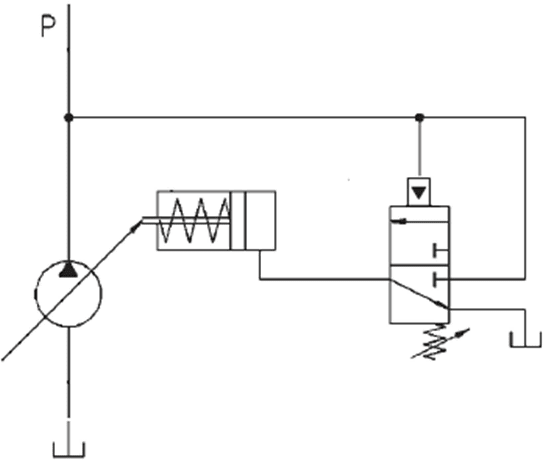Backgound,
I have a small eaton-vickers pump that looks almost like this only mine is green.
It has a 5 HP motor driving a 5 gpm pump at full flow.
We no problems with setting the system pressure at about 1500 psi when there is no flow. We can't adjust it much higher because the 5HP motor is limited.
The pump should provide no flow at 1500 psi.
The question I have is at what pressure do I get full flow?
It seems to me this is a function of the spring. Adjust the spring in and out adjust a proportional band where the flow is proportional to the pressure drop from 1500 psi. However, there is no way to know how far the pressure must drop to get the full 5 gpm from the pump. It seems to me that this would be a function of the spring constant. A stiffer spring would more cause the port to the swash plate to open up more with a smaller pressure drop. This essentially is changing the proportional band of the pump.
Are there specifications for this?
Are there specifications for how fast the swash plate moves?
Is it possible to replace the spring in the compensator?
As a controls person this seems simple but crude.
BTW, know the flow because I can measure the speed of the piston and know the areas of the piston but I am looking for a general case.
Peter Nachtwey
Delta Computer Systems
I have a small eaton-vickers pump that looks almost like this only mine is green.
It has a 5 HP motor driving a 5 gpm pump at full flow.
We no problems with setting the system pressure at about 1500 psi when there is no flow. We can't adjust it much higher because the 5HP motor is limited.
The pump should provide no flow at 1500 psi.
The question I have is at what pressure do I get full flow?
It seems to me this is a function of the spring. Adjust the spring in and out adjust a proportional band where the flow is proportional to the pressure drop from 1500 psi. However, there is no way to know how far the pressure must drop to get the full 5 gpm from the pump. It seems to me that this would be a function of the spring constant. A stiffer spring would more cause the port to the swash plate to open up more with a smaller pressure drop. This essentially is changing the proportional band of the pump.
Are there specifications for this?
Are there specifications for how fast the swash plate moves?
Is it possible to replace the spring in the compensator?
As a controls person this seems simple but crude.
BTW, know the flow because I can measure the speed of the piston and know the areas of the piston but I am looking for a general case.
Peter Nachtwey
Delta Computer Systems

